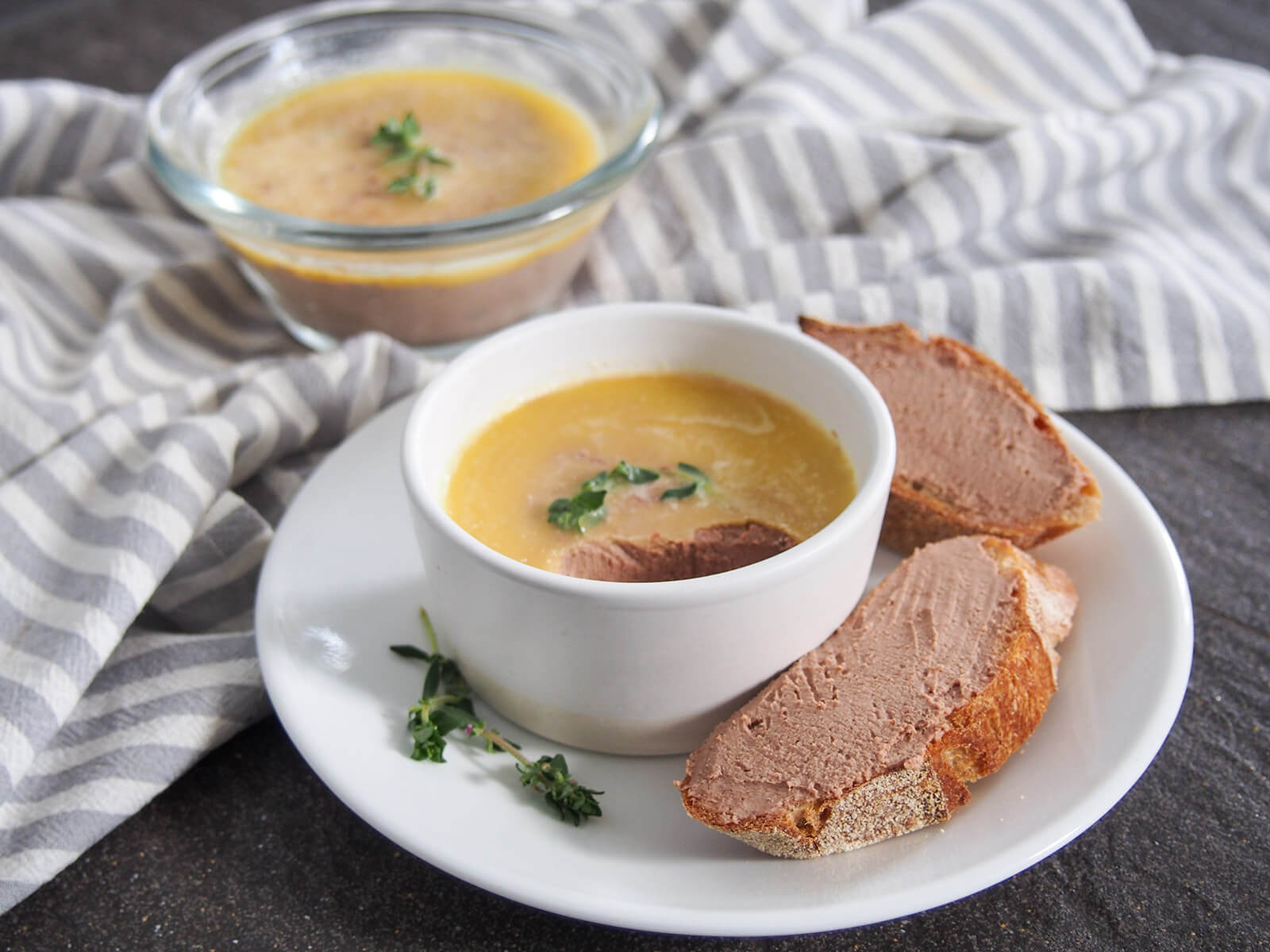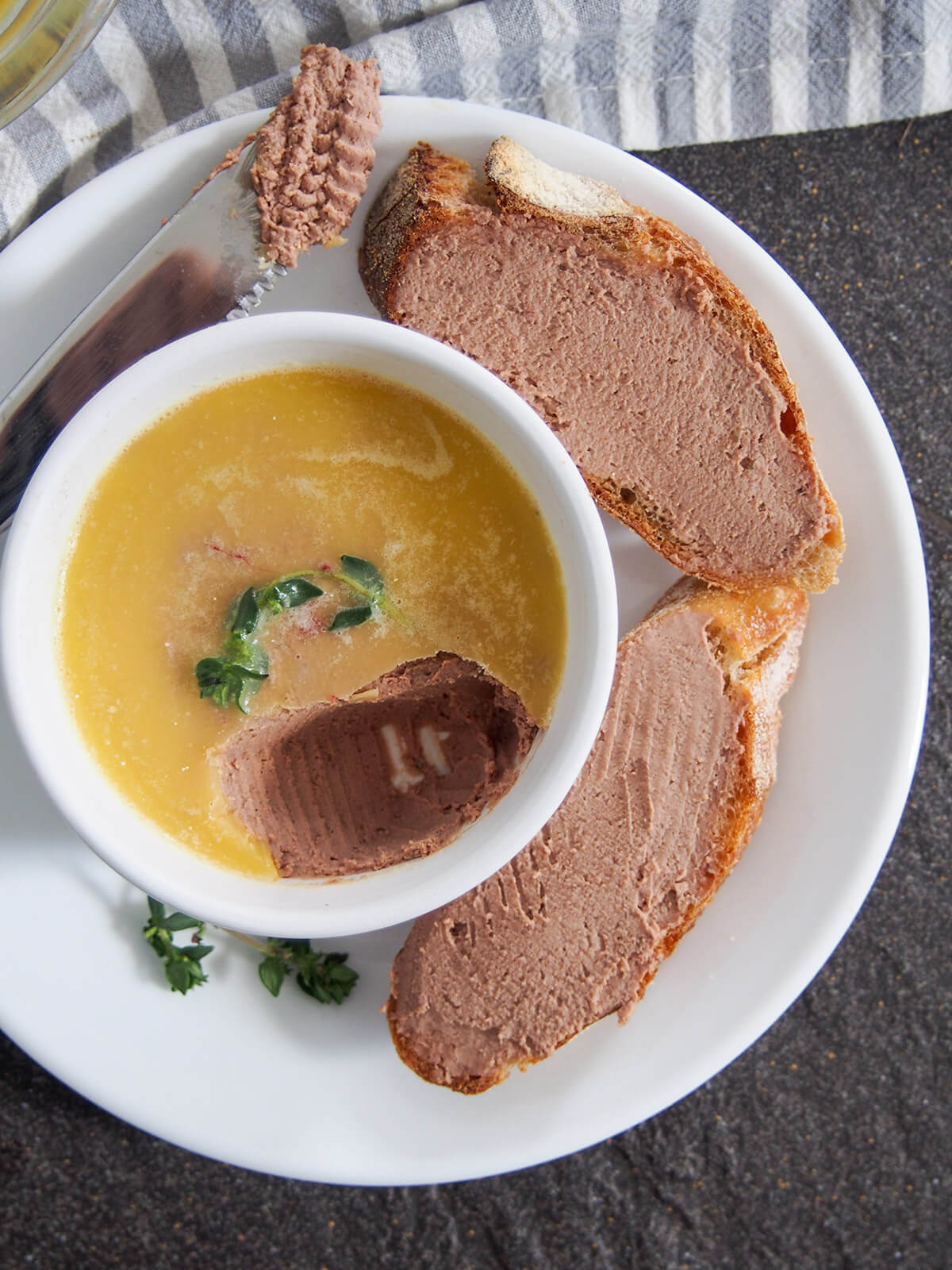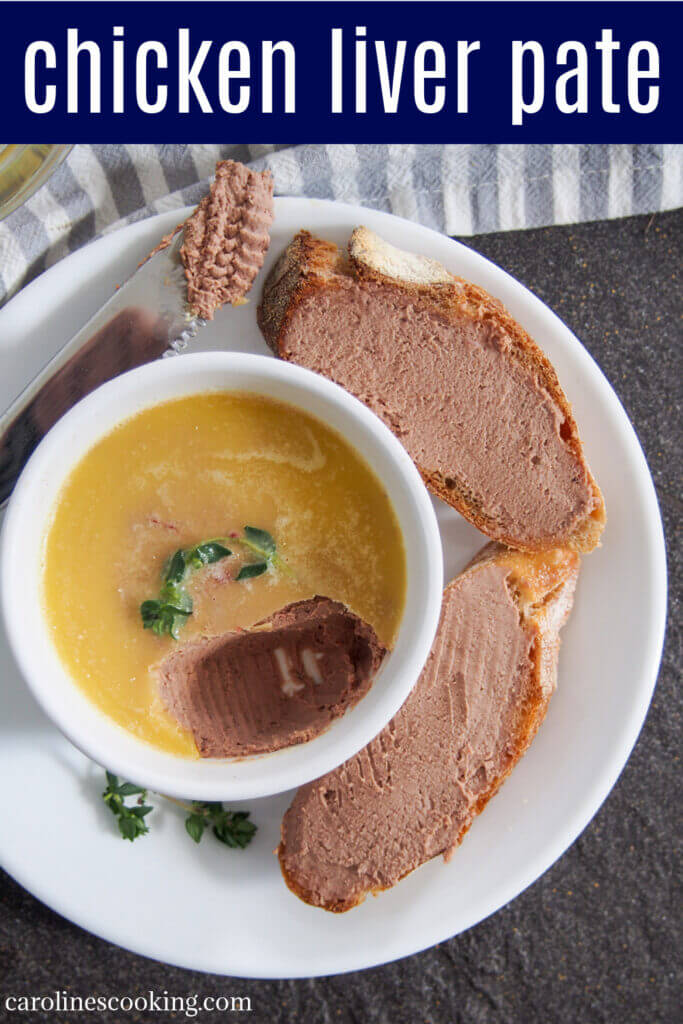Chicken liver pâté (pate) is a classic appetizer or addition to a charcuterie board, with a wonderfully smooth and gently rich flavor. It's also really easy to make and is perfect to make ahead for entertaining.

This post may contain affiliate links, where we earn from qualifying purchases. See more details in the policy page.
These days, chicken liver pâté is one of those things that might seem like a bit of a retro classic. For whatever reason, it was very popular for a while and has become less popular. Maybe it's just that liver in general is not seen as an appealing ingredient.
But it's worth setting aside any reservation you may have about liver. This pâté doesn't have any of that overly-irony flavor you might have in mind. Instead, it's smooth and delicately rich. Plus even better, it's easy and very cost-effective to make.

What's the difference between pâté and terrine?
Many countries have ways of making lesser cuts and offal into tasty treats, but France is probably best known for them. In general, a pâté is a smooth paste and should include at least some kind of liver.
A terrine has a coarser texture, often including chunks of meat, though these days you will find vegetarian ones as well. The name terrine actually comes from the traditional dish it is moulded in, before being baked in a bain Marie (water bath).
"Pâté de fois de vollaille", as it is called in French, is a popular, traditional spread in France. Chicken livers have a mild flavor, cook quickly and blend up into a lovely smooth paste, particularly with the help of some butter.
It's perfect served simply with some nice crusty bread or crackers, ideally paired with a glass of red wine.

Variations on this traditional French pate
You'll find a few variations in the ingredients for this, though most include chicken liver, onion or shallot, garlic and butter. Some including more butter, some add hard boiled eggs or cream and you'll find different cooking techniques. One is to cook it in the oven, but personally I find this unnecessary work here (it's perfect for terrines, but this doesn't really need it).
There are two other main ways to make this pate. One is to simmer the liver and onion in stock or other liquid, the other is to sauté them in butter. Personally, I have gone with the latter as I think you get a better flavor that way.
Most recipes add some form of alcohol to add to the flavor. The most traditional is brandy (cognac) as I used here, but you could also use port, red wine or even whisky. It's worth simmering gently after you add the brandy to boil off the alcohol and take the edge off the flavor.
Pâté ingredients
This pâté uses a traditional set of ingredients, as mentioned above, that are all pretty common:
- Chicken liver - the main ingredient! These are actually often easier to find than you might think, they might just not have noticed them in your supermarket. Make sure they are fresh to avoid an overly strong flavor.
- Butter - this adds some extra richness in cooking and also a protective cover to the end pâté.
- Shallot - this adds some aromatic depth of flavor. Shallots are a little sweeter and milder than many onions, though if you can't find them, a sweet onion works instead.
- Thyme - just a little helps add a nice gentle aromatic flavor.
- Brandy - this adds depth of flavor to the pâté.
Top tip: trim the liver
As well as making sure you choose fresh chicken livers, also take time to trim them before cooking. You want to get rib of any fat, connective tissue etc that may make them tough.

How to avoid a grainy pate
There are two main reasons for pate having a grainy texture. One is overcooking the liver, and the other is not making a smooth enough puree. In terms of cooking, the liver should cook and brown on the outside but still be pink on the inside. It only takes a couple of minutes, especially if you chop it up.
While the cooking is most responsible for graininess, it's also worth blending it well, too. You can help the texture by pushing through a fine strainer at the end. I know it might seem a little extra work, but having tried it both ways it is definitely that bit smoother.
Personally I like it both with a little more texture, and very smooth (in the photo above, the one in front is strained, behind is not). So it depends on your personal preference, I think, and how you plan to use it.
Storing pate
The top of the pate will quickly discolor when it is exposed to the air. You can press a layer of cling wrap/film on top which will help, but to keep it better, it's worth adding either a layer of jelly, or better (I think), clarified butter. Making clarified butter is quick and it makes quite a nice looking top to the pate.
Without a layer on top, it will keep just a day or two in the fridge. With the protective layer of butter, it will keep for around 5 days. To use the pate soon, store it in the fridge.
For longer storage, you can freeze it for a couple of months though make sure it is well sealed. Either way, it's worth dividing the pate into smaller dishes so you only need to have a small amount open at a time.

Chicken liver pâté is really so much easier to make than you might think, and has a wonderfully smooth texture and delicately rich flavor. It's perfect to snack on as part of lunch, or used to make appetizers or canapés (like pate crostini with blackberry jam). Perfect for entertaining and more.
Try these other appetizers great for entertaining:
- Sausage rolls (with a pork-y filling and crisp, flaky pastry)
- Baked mussels (topped with buttery, herby crumbs)
- Smoked salmon pate (another delicious spread)
- Prosciutto wrapped dates (so easy and tasty)
- Plus get more appetizer recipes in the archives.
Chicken liver pâté
Ingredients
For pate
- ½ lb chicken livers
- 1 shallot small
- 1 clove garlic
- 2 ½ tablespoon butter divided, room temperature
- ¼ teaspoon fresh thyme leaves only, chopped
- 2 tablespoon brandy
For butter seal on top
- 2 tablespoon butter or more if wider dishes (to form layer to cover)
- thyme sprigs to garnish (optional)
Instructions
- Start by cleaning the chicken livers - you want to get rid of any bits that may become tough. Find any white fat or connective tissue on a piece of liver and hold on to it as you use use your knife to take off the liver flesh. Remove the fat/connective tissue and roughly chop the liver. Repeat with the other pieces.
- Peel and finely dice the shallot and garlic. Warm ½tbsp (6g) butter in a skillet/frying pan over a medium heat and add the shallot. Cook, stirring, for a minute, then add the garlic.
- After another minute or two, as the onion is starting to soften and become translucent, add the liver and thyme. Cook for around 3 minutes on each side until lightly cooked on the outside but still pink in the middle.
- Add the brandy to the skillet/pan and stir gently to help the brandy evaporate off the alcohol and reduce. After a minute or two it will become almost syrup-like, then remove from the heat.
- Scrape the contents of the skillet/pan into a food processor and add the remaining 2tbsp butter. Blend until the mixture is very smooth. If you want an extra-smooth pate, then press the mixture through a fine mesh sieve.
- Either way, then transfer the pate to two or more small ramekins/dishes and flatten the top. If you don't want to top with butter, place cling wrap/film over the top of the pate, pressing on to the surface and ideally then also cover with a lid. Refrigerate and use within a day or two or freeze until needed. If adding butter, cover and chill in the fridge to firm up for around 25-20 minutes.
Adding butter seal
- To keep it fresher a little longer (around 5 days) until you start using, add a clarified butter seal. Melt the 2-3tbsp butter in a small skillet then once melted, remove from the heat. Skim off the foamy white part on top of the butter so just the clear yellow butter remains.
- Pour the melted butter over the top of the chilled pate in the ramekins, swirling gently if needed to form a layer all over. If you can't form a layer, you may need more butter (eg if your dish is wider but 2-3tbsp should be enough). If you like, press a little stem of thyme into the butter while it is still liquid. Place the dishes in the fridge until needed (or you can also freeze).
Video
Nutrition
See some of my favorite cooking tools and ingredients in the Caroline's Cooking Amazon store.
Remember to pin for later!




Susan Steward says
Good recipe. I soaked livers in milk before sautéing. I added 1/4 cup heavy cream and 2 triangles of ‘The Laughing Cow’ cheese. All made a very nice slush which formed up super smooth puree after whipping it up in food processor. I think a blender would be better - to get more air into it. Still, very satisfied with final product.
Caroline's Cooking says
Glad you enjoyed! Yes I can imagine a blender may make it slightly lighter, if that's the texture you are looking for (though personally I have always tended to have and enjoy simply smooth rather than that bit airy).
The Yank says
Also need fresh ground pepper and salt.serve with dry flattened toast with green onions,tomato,cucumber.yum,yum.try it as a toasted sandwich with sliced onion,tomato. This was my favorite late night snack wile working in Ireland staying at Fitzpatrick's castle hotel after a nite of the drink.
Caroline's Cooking says
You can certainly add a little salt and pepper to taste as well (though I do find the other flavorings are pretty good as they are and you don't want to over-do). And does indeed make a great snack!
Amanda Dixon says
We love doing at-home date nights with a charcuterie board, cheese and plenty of wine, and this is always my favorite recipe to add to the board for an elegant touch. It's unbelievably creamy and decadent -- totally makes the night extra special so thank you!
Caroline's Cooking says
Yes, I can definitely see it working well as part of a board, glad to hear you enjoyed.
Hanif says
I added capers to this mix !
Caroline's Cooking says
Yes, they can definitely be good in there too.
Jacqueline Meldrum says
This is crying out for some Scottish oatcakes.
Caroline's Cooking says
Yes indeed! I love making my own oatcakes and they definitely work well with this.
don fitch says
Thanks, though I think of it as more of a Process than a Recipe. (The herbs are all optional, and as much butter is used as is needed.) For my palate, the blender needs to be used a whole lot. Living in an Old Folks' Home, with only a microwave for cooking, this is a bit tricky, but can be done, and it's Delicious.
Caroline's Cooking says
I can imagine a little tricky, but well done persevering! And yes, as with so many recipes you can adjust to taste and how it feels/looks with your specific ingredients. Glad you enjoyed.
anna says
I just love it, it came out so delicious! Thank you so much 🙂
Caroline's Cooking says
Glad you enjoyed, that's great to hear!
Michelle says
This pate is perfectly smooth and rich. It's a lovely festive starter or appetizer. I have happy memories of my Grandad making this at Christmas. Great tips for avoiding a grainy pate too!
Caroline's Cooking says
Thank you, I have memories of this as a child as well. It really is such a lovely pate!
Caitlyn Erhardt says
This was so smooth and a great party appetizer. Thank you for all the tips as well to make the texture perfect!
Caroline's Cooking says
Thanks, glad to hear the tips were helpful.
Diego Ravignani says
A big thanks from Argentina! It made a perfect comfort food this Sunday night. Cheers!
Caroline's Cooking says
So glad to hear you enjoyed -and agree it's comfort food for sure!